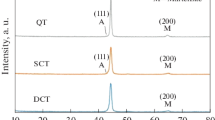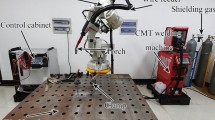Abstract
Steels are subjected to different conventional heat treatment (CHT) processes such as annealing, normalizing, hardening, tempering, quenching, and stress relieving, to improve the mechanical properties and surface coating methods such as electroplating, laser coating, CVD, and PVD, and to enhance the tribological and corrosion properties. Cryogenic treatment is usually performed after CHT to further improve these properties. Components with friction surfaces require high surface hardness in order to resist wear. In this work, EN31 steel used in bearings, spline shafts, and tiller blades, is surface-hardened using gas tungsten arc (GTA). To further improve the hardness, cryogenic treatment was done. GTA torch uses thoriated tungsten (2%) electrode to apply the heat on the friction surface. The welding current and angle of the electrode tip were varied to obtain different heat inputs during surface hardening process. Cryogenic treatment was done for five different soaking periods at − 50 °C [shallow cryogenic treatment (SCT)] and − 196 °C [deep cryogenic treatment (DCT)]. Shallow cryogenic treatment was performed using dry ice, and deep cryogenic treatment was performed using liquid nitrogen. Micro-hardness and microstructures of the specimen were studied. Microstructure study shows that considerable amount of retained austenite has been transformed to plate martensite with precipitates of carbide particles, increasing the hardness of the surface. Surface hardness increases with current and soaking period. The maximum hardness is obtained at 200 A for all electrode tip angles. The maximum hardness is obtained at 15 h of soaking period. Specimens treated at − 190 °C were found to exhibit higher hardness than specimens treated at − 50 °C. Further, 200 A welding current with 45° electrode tip angle and 15 h of soaking period for both SCT and DCT is found to produce maximum hardness.






Similar content being viewed by others
References
X. Tao, C. Li, L. Han, J. Gu, J. Mater. Res. Technol. 5, 1–13 (2015)
K.T. Cho, K. Song, S.H. Oh, Y.K. Lee, W.B. Lee, Surf. Coat. Technol. 232, 912–919 (2013)
M. Ramezani, T. Pasang, Z. Chen, T. Neitzert, D. Au, J. Mater. Res. Technol. 4, 114–125 (2015)
R. Fragoudakis, S. Karditsas, G. Savaidis, N. Michailidis, Procedia Eng. 74, 309–312 (2014)
S. Sackl, G. Kellezi, H. Leitner, H. Clemens, S. Primig, Mater. Today Proc. 2, S635–S638 (2015)
J. Suchanek, V. Kuklik, Wear 267, 2100–2108 (2009)
S. Hernandez, J. Hardell, H. Winkelmann, M.R. Ripoll, B. Prakash, Wear 338–339, 27–35 (2015)
S. Zhirafar, A. Rezaeian, M. Pugh, J. Mater. Process. Technol. 186, 298–303 (2007)
D. Senthilkumar, I. Rajendran, M. Pellizzari, J. Siiriainen, J. Mater. Process. Technol. 211, 396–401 (2011)
M. Preciado, P.M. Bravo, J.M. Alegre, J. Mater. Process. Technol. 176, 41–44 (2006)
M. Singh, H. Singh, Int. J. Res. Eng. Technol. 03, 169–173 (2014)
A. Molinari, M. Pellizzari, S. Gialanella, G. Straffelini, K.H. Stiasny, J. Mater. Process. Technol. 118, 350–355 (2001)
M. Pérez, C. Rodríguez, F.J. Belzunce, Procedia Mater. Sci. 3, 604–609 (2014)
S.S. Gill, H. Singh, R. Singh, J. Singh, Int. J. Adv. Manuf. Technol. 48, 175–192 (2010)
T. Yugandhar, P.K. Krishnan, C.V.B. Rao, R. Kalidas, 6th Int. Tool. Conf. 24, 671–684 (2002)
A. Oppenkowski, S. Weber, W. Theisen, J. Mater. Process. Technol. 210, 1949–1955 (2010)
P.I. Patil, R.G. Tated, Int. J. Comput. Appl. 9, 10–29 (2012)
D. Das, A.K. Dutta, K.K. Ray, Wear 267, 1371–1380 (2009)
P. Sekhar Babu, Int. J. Res. Eng. Technol. 3, 17–20 (2015)
A. Idayan, A. Gnanavelbabu, K. Rajkumar, Procedia Eng. 97, 1683–1691 (2014)
K. Kamei, A.G. William, L. Koveile, N. Ahmad, A. Chakravorty, R. Davis, IOSRJ. Mech. Civ. Eng. 11, 17–22 (2014)
S. Harish, A. Bensely, D. Mohan Lal, A. Rajadurai, G.B. Lenkey, J. Mater. Process. Technol. 209, 3351–3357 (2009)
R. Saravanan, R. Sellamuthu, Appl. Mech. Mater. 592–594, 53–57 (2014)
R. Saravanan, R. Sellamuthu, Procedia Eng. 97, 1348–1354 (2014)
A.U. Orlowicz, A. Trytek, Weld. Int. 19, 341–348 (2005)
S.G. Sapate, A.D. Chopde, P.M. Nimbalkar, D.K. Chandrakar, Mater. Des. 29, 613–621 (2008)
G. Kocher, O. Parkash, S. Vardhan, Int. J. Emerg. Technol. Adv. Eng. 2, 102–105 (2012)
A.A. Sadek, M. Ushio, F. Matsuda, Metall. Trans. A Phys. Metall. Mater. Sci. 21, 3221–3236 (1990)
M. Ushio, A.A. Sadek, F. Matsuda, Plasma Chem. Plasma Process. 11, 81–101 (1991)
S. Murugappan, S. Arul, C. Campus, Int. J. Appl. Eng. Res. 10, 21549–21563 (2015)
S. Murugappan, S. Arul, Int. J. Appl. Eng. Res. 10, 31329–31340 (2015)
S. Murugappan, S. Arul, S.K. Narayanan, Procedia CIRP 35, 61–66 (2015)
A.W. Orłowicz, A. Trytek, Metall. Mater. Trans. A 34, 2973–2984 (2003)
N.A. Özbek, A. Çiçek, M. Gülesin, O. Özbek, Int. J. Mach. Tools Manuf. 86, 34–43 (2014)
R. Choudhary, H. Kumar, R.K. Garg, Indian J. Eng. Mater. Sci. 17, 91–98 (2010)
N.H. Jun, Y. Lv, L. Mi, H. Liu, Int. Conf. Mater. Mech. Manuf. Eng. (2015). https://doi.org/10.2991/ic3me-15.2015.210
B.R. Chandra, S. Arul, R. Sellamuthu, Procedia Mater. Sci. 5, 2369–2375 (2014)
F.W. Breyfogle, Implementing Six Sigma—Smarter Solutions Using Statistical Methods (Wiley, Hoboken, 1999)
Author information
Authors and Affiliations
Corresponding author
Additional information
Publisher's Note
Springer Nature remains neutral with regard to jurisdictional claims in published maps and institutional affiliations.
Rights and permissions
About this article
Cite this article
Chaanthini, M.K., Sanjivi, A. Improving Surface Hardness of EN31 Steel by Surface Hardening and Cryogenic Treatment. J. Inst. Eng. India Ser. D 100, 37–42 (2019). https://doi.org/10.1007/s40033-019-00177-2
Received:
Accepted:
Published:
Issue Date:
DOI: https://doi.org/10.1007/s40033-019-00177-2




